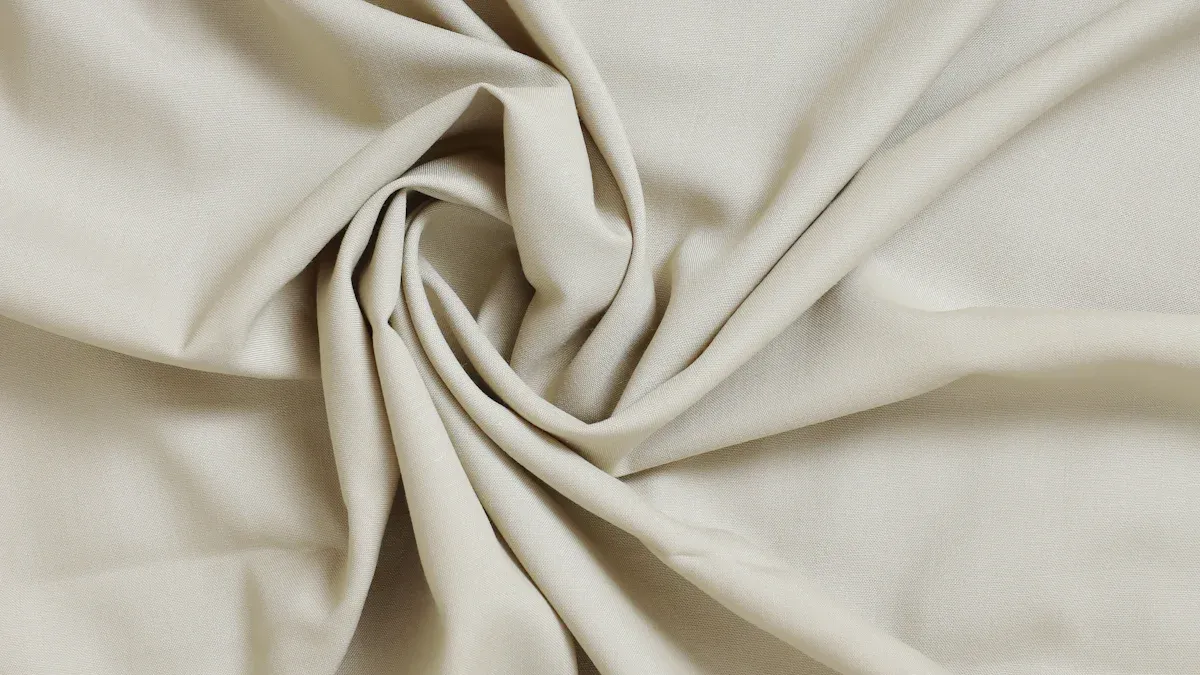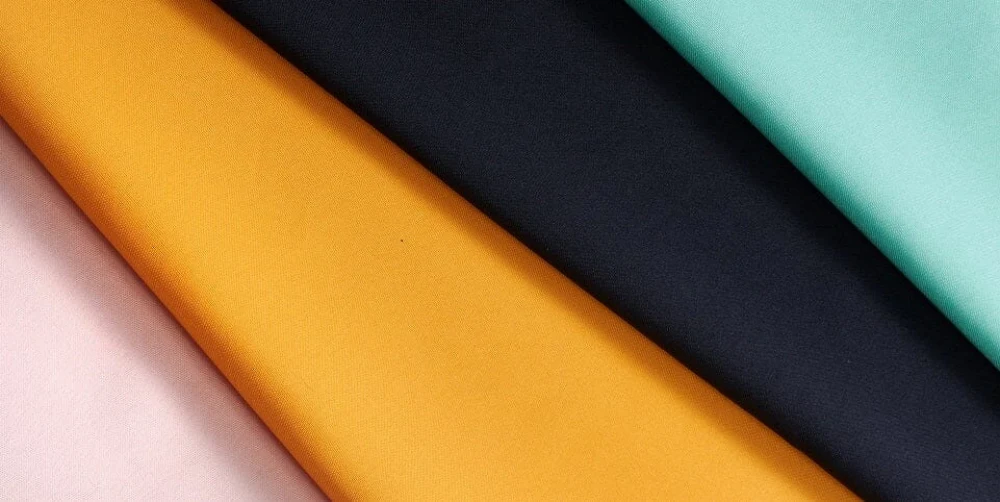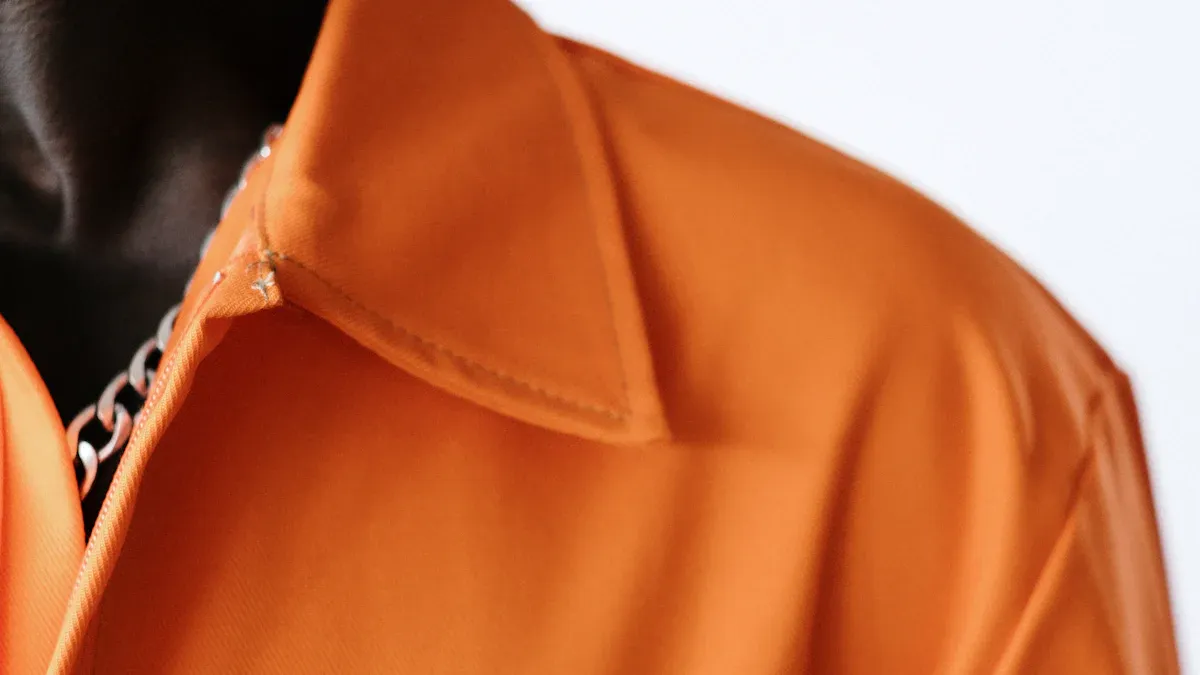
If you’ve ever wondered what is polyester poplin fabric, you’re not alone. This fabric blends the strength of polyester with the smooth, crisp feel of poplin, making it a favorite for many projects. You’ll see it everywhere—from shirts and dresses to bedding and crafts. Take a look at how versatile it can be:
Sector | Common Uses of Polyester Poplin Fabric |
|---|---|
Apparel | Shirts, dresses, skirts, pants, accessories |
Home Decor | Bed sheets, pillowcases, curtains |
Crafting | Quilting, embroidery, appliqué projects |
You can always count on Fanda Fabrics for high-quality poplin options, whether you’re sewing for fashion, your home, or your next creative idea.
Key Takeaways
Polyester poplin fabric combines polyester’s strength with poplin’s smooth, crisp texture, making it lightweight, durable, and wrinkle-resistant.
This fabric works well for clothing, home decor, and event uses because it holds its shape, resists stains, and comes in many colors and patterns.
Polyester poplin is easy to care for with simple washing and drying steps, and it keeps its color and quality after many washes.
While it offers great durability and low maintenance, polyester poplin has limited stretch and can feel less breathable than natural fabrics.
Choosing polyester poplin means getting a fabric that looks polished, lasts long, and suits a wide range of projects from uniforms to table linens.
What is Polyester Poplin Fabric?

Definition
If you’re curious about what polyester poplin fabric is, you’re in the right place. This fabric combines the smooth, crisp feel of poplin with the strength of polyester fibers. You get a textile that’s lightweight, soft, and has a subtle sheen.
The secret lies in its tight plain weave, which gives poplin cloth its signature fine ribs and smooth surface. Polyester poplin fabric stands out because it resists wrinkles, holds its shape, and feels comfortable against your skin. You’ll find it in everything from work shirts to tablecloths and even event decorations.
Here’s a quick look at what makes up polyester poplin fabric:
Component | Technical Characteristics |
|---|---|
Polyester Fiber | Synthetic, strong, wrinkle-resistant, keeps its shape, resists fading, dries quickly |
Poplin Fabric | Fine texture, lightweight, smooth hand feel, clear weave, subtle shine, soft to the touch |
You might wonder, what is poplin fabric in general? Poplin cloth refers to any fabric with this tight, plain weave and smooth finish. When you add polyester, you get a fabric that’s even more durable and easy to care for.
Fanda Fabrics offers a wide range of poplin textiles, including both polyester and cotton options, so you can always find the right material for your project.
How It’s Made?
Let’s break down how polyester poplin fabric comes to life. The process starts with creating polyester fibers from chemicals. These fibers then get woven into poplin cloth using a special technique. Here’s how it happens, step by step:
Manufacturers create polyester by combining purified terephthalic acid (PTA) and ethylene glycol (EG) to form long-chain polymers.
They melt these polymers and push them through tiny holes (spinnerets) to make continuous filaments.
The filaments cool and solidify, then get stretched to boost their strength and elasticity.
Next, the fibers are wound onto spools and textured for softness or extra stretch.
The yarns are prepared for weaving, with warp and weft threads set up on a loom.
Weaving begins, using a plain weave pattern that gives poplin textiles their smooth, ribbed texture.
After weaving, the fabric goes through finishing treatments like dyeing, printing, wrinkle resistance, and water repellency.
Quality control checks happen throughout, making sure the final poplin cloth meets high standards.
This process creates a fabric that’s not only strong and smooth but also easy to care for and available in a huge range of colors and patterns.
Key Features
You’ll notice right away that polyester poplin fabric feels smooth and looks polished. It’s lightweight, yet tough enough for daily wear. Here’s a table to help you see how it stacks up against other woven fabrics:
Feature/Aspect | Polyester Poplin Characteristics | Comparison to Other Woven Fabrics |
|---|---|---|
Texture and Weave | Smooth, fine ribs, tight plain weave | Smoother than twill, tighter than linen |
Strength and Durability | Strong, resists stretching and shrinking | Tougher than cotton poplin, more durable than many fabrics |
Wrinkle Resistance | Resists wrinkles, easy to maintain | More wrinkle-resistant than linen |
Weight and Breathability | Lightweight, breathable | Lighter than twill, better for summer |
Stain Resistance | Resists stains, easy to clean | More stain-resistant than cotton or linen |
Color Retention | Keeps color well over time | Better than cotton poplin |
Comfort | Soft, comfortable, breathable | More comfortable than heavier weaves |
You’ll find polyester poplin textiles in a rainbow of colors and a wide variety of patterns. Whether you want classic black, navy, or something bold like fuchsia or emerald green, there’s a shade for every taste. Patterns range from solids and stripes to florals and geometric prints, making poplin cloth a favorite for both fashion and home decor.
Polyester poplin fabric often comes in blends, too. Cotton/polyester blends combine the softness and breathability of cotton with the durability and easy care of polyester. This makes poplin textiles perfect for shirts, pants, uniforms, and even upholstery.
When you shop with Fanda Fabrics, you get access to poplin cloth that meets strict quality standards. Many options carry certifications like OEKO-TEX Standard 100, which means the fabric is safe for you and your family.
Some poplin textiles even use recycled polyester and meet the Global Recycle Standard (GRS), supporting a more sustainable future.
Tip: If you want a fabric that’s easy to sew, holds its shape, and looks great wash after wash, polyester poplin fabric is a smart choice. Fanda Fabrics offers a wide selection of poplin textiles, so you can always find the right fit for your next project.
Polyester Poplin Fabric Characteristics
Weave and Texture
When you touch polyester poplin, you’ll notice how smooth and flat it feels. The weave structure uses a simple under-over pattern, where the threads cross each other evenly. This plain weave gives poplin cloth its signature surface—no raised ribs, just a sleek finish that feels soft and looks polished.
Unlike older versions of poplin textiles that had visible ridges, modern polyester poplin has a flat, even texture. You’ll find it easy to iron and it rarely wrinkles, which makes it a favorite for both clothing and home decor.
Weight
Polyester poplin sits in the lightweight category. Most poplin textiles weigh between 100 and 170 GSM (grams per square meter), or about 3 to 5 ounces per yard. This weight makes the fabric soft, breathable, and easy to drape.
You can use it for shirts, dresses, linings, or even curtains. The lightweight feel means you get comfort without bulk, so your projects stay cool and flexible.
Stretch and Flexibility
If you’re looking for a fabric with lots of stretch, polyester poplin might surprise you. The tight plain weave keeps the fabric stable and firm, so it doesn’t stretch much at all. This is great when you want your poplin cloth to hold its shape, like in uniforms or tablecloths.
Some poplin textiles blend in spandex or elastane for extra stretch, but standard polyester poplin stays pretty rigid. You get a crisp, structured look every time.
Note: If you need more flexibility, try a poplin blend with spandex. For most uses, though, the stability of polyester poplin is a big plus.
Durability and Care
One of the best characteristics of poplin fabrics is their durability. Polyester poplin stands up to daily wear and frequent washing. It resists wrinkles, so you spend less time ironing. To keep your poplin textiles looking fresh, wash them in cold water and avoid harsh chemicals.
Air-drying or using low heat in the dryer helps the fabric last longer. With proper care, your poplin cloth can last five to seven years, even with regular use. That’s a solid investment for any project.
Here’s a quick look at how polyester poplin holds up:
Fabric | Strength Retention After Washes | Typical Lifespan (Years) | Care Notes |
|---|---|---|---|
Polyester Poplin | ≥90% after 50 washes | 5 to 7 | Machine wash cold, tumble dry low, wrinkle resistant |
You can count on these characteristics to make polyester poplin a reliable choice for both fashion and home projects.
Polyester Poplin vs Other Poplin Fabrics
When you start exploring the different types of poplin fabric, you’ll notice that each one brings something special to the table. Let’s break down how polyester poplin stacks up against other popular options from Fanda Fabrics.
Polyester vs Cotton Poplin (Fanda Fabrics)
You might wonder which is better for your project: polyester poplin or cotton poplin. Here’s a quick comparison to help you decide:
Attribute | Cotton Poplin | Polyester Poplin |
|---|---|---|
Breathability | High; feels cool and soft | Lower; less moisture absorption |
Wrinkle Resistance | Moderate; may need ironing | Excellent; needs little ironing |
Cost | Higher, premium feel | More affordable |
Cotton poplin fabric feels soft and breathable, making it perfect for summer shirts and dresses.
Polyester poplin resists wrinkles and stains, so you spend less time on care.
If you want something budget-friendly and easy to maintain, polyester poplin is a smart pick.
For comfort and a natural feel, poplin cotton fabric is the way to go.
Tip: If you sew uniforms or need low-maintenance poplin textiles, polyester poplin works best. For casual or formal wear, cotton poplin shines.
Polyester vs Poplin Lining Fabric
Poplin lining fabric is another type you’ll see often. It’s usually lightweight and smooth, designed to line the inside of garments.
Polyester poplin is tough, holds its shape, and works well for outerwear, uniforms, and even home décor.
Poplin lining fabric adds structure inside jackets, skirts, or dresses without adding bulk.
Both fabrics are easy to care for and affordable, but you’ll use polyester poplin for the outside and poplin lining for the inside.
You get durability and a polished look with polyester poplin, while poplin lining fabric keeps your clothes comfortable and neat on the inside.
Polyester vs Woven and Solid Poplin
Woven poplin and solid poplin are two more types of poplin fabric you’ll find at Fanda Fabrics.
All these poplin textiles share a plain weave, giving them a smooth, crisp finish.
Polyester poplin uses synthetic fibers, so it’s stronger and more wrinkle-resistant than 100% cotton woven poplin.
Solid poplin refers to the color—think classic, single-color fabrics that work for shirts, dresses, and crafts.
You’ll often see polyester poplin in tablecloths, drapes, and uniforms because it’s durable and easy to clean. Woven poplin and solid poplin, especially in cotton, are favorites for clothing thanks to their softness and breathability.
Note: When you choose between these types of poplin fabric, think about where you’ll use them. Polyester poplin is great for projects that need strength and easy care. Cotton or woven poplin is best for comfort and style.
What is Polyester Poplin Fabric Used For?

When you think about what is poplin fabric used for, you’ll find that polyester poplin fits into so many parts of daily life. Its smooth texture, durability, and easy care make it a favorite for clothing, home decor, and even big events. Let’s look at the main uses for poplin fabric and see how you can make the most of it.
Apparel
You’ll spot polyester poplin in all kinds of clothing. It works well for shirts, blouses, dresses, skirts, and uniforms. The fabric feels lightweight and crisp, so you stay comfortable all day.
Polyester poplin resists wrinkles, which means you spend less time ironing and more time enjoying your outfit. Many uniforms for schools, hospitality, and healthcare use poplin because it holds up to frequent washing and keeps a neat look. If you want to sew your own clothes or need fabric for a group project, Fanda Fabrics offers a wide range of poplin options to suit your style.
Home Decor
Polyester poplin shines in home decor projects. You can use it for tablecloths, curtains, pillowcases, and even upholstery. The fabric’s tight weave and durability make it perfect for both indoor and outdoor settings. Take a look at how poplin fits into your home:
Home Decor Products | Durability and Fabric Characteristics |
|---|---|
Tablecloths and Covers | Durable, wrinkle-resistant, lightweight, suitable for indoor/outdoor use |
Curtains and Drapery | Soft touch, great draping, long-lasting vibrant colors |
Backdrops and Banners | High durability, print, and colors do not fade or wash out |
Upholstery | Durable and resilient, suitable for small accent pieces and larger furniture |
Beddings (bed sheets, pillowcases) | Durable, easy maintenance, long-lasting |
You get a fabric that looks great, lasts for years, and is easy to clean. Fanda Fabrics supplies poplin in many colors and patterns, so you can match any room or occasion.
Commercial and Event Uses
Polyester poplin stands out in commercial and event settings. You’ll see it at weddings, conferences, hotels, and trade shows. Event planners love poplin for table linens, banners, and branded displays because it resists stains and wrinkles.
The fabric’s wide widths mean fewer seams and a cleaner look for large backdrops or table covers. Businesses choose poplin for uniforms and branded items since it holds color well and looks professional after many washes.
If you need fabric for a big event or business, Fanda Fabrics has the quality and variety to help you create a polished, lasting impression.
Tip: Polyester poplin is a go-to choice when you want something that looks sharp, lasts long, and is easy to care for—whether you’re dressing up, decorating your home, or planning an event.
Pros, Cons, and Care
Advantages
You’ll find plenty of reasons to love polyester poplin. Here are some of the top benefits:
It resists wrinkles, so you spend less time ironing.
The fabric holds its shape, even after many washes.
You get a lightweight feel that’s still strong and durable.
Colors stay bright and don’t fade easily.
Stains come out with little effort, making it great for busy households.
The tight weave gives you a smooth, polished look for both clothing and home decor.
Tip: If you want a fabric that looks crisp and stays fresh, poplin is a smart choice for shirts, uniforms, and table linens.
Disadvantages
Polyester poplin isn’t perfect for every project. Here are some things to keep in mind:
The fabric doesn’t stretch much, which can feel tight in fitted clothes.
It can wrinkle, so you might need to iron or steam it more often.
Polyester is petroleum-based and non-biodegradable, which means it isn’t eco-friendly.
Washing releases microfibers that can end up in the oceans.
The fabric sometimes feels less breathable, trapping heat and sweat.
Static cling and pilling can happen over time.
Sewing can be tricky because the fabric is slippery and tough to pierce with a needle.
Note: If you want a fabric that’s better for the environment or more breathable, you might want to try cotton poplin instead.
Care Instructions
Taking care of polyester poplin is easy if you follow a few simple steps:
Wash in cold or warm water using a gentle or delicate cycle.
Use mild detergent and avoid bleach.
Air dry by hanging or laying flat, or tumble dry on low heat. Remove while slightly damp to cut down on wrinkles.
Iron at medium heat while the fabric is still a bit damp. Use a little steam for stubborn wrinkles.
Always check the care label before washing or ironing.
If you get a stain, act fast! Here’s a quick guide for common stains:
Stain Type | Best Solution | Why It Works |
|---|---|---|
Sweat | Vinegar | Neutralizes odor and breaks down proteins |
Ink/Paint | Rubbing Alcohol | Lifts pigments quickly |
Oil/Grease | Baking Soda + Dish Soap | Absorbs and cuts through grease |
Coffee/Wine | Vinegar + Baking Soda | Tackles acidity and absorbs liquids |
Food | Dish Soap + Laundry Detergent | Breaks down food particles |
Tip: Always blot stains gently and rinse with cold water. Avoid hot water and never use bleach on poplin.
Conclusion
When you choose polyester poplin, you get a fabric that stands up to daily life. It offers durability, easy care, and vibrant color that lasts. You can use poplin for uniforms, home decor, or creative projects because it adapts to so many needs.
Fanda Fabrics gives you reliable quality and plenty of options, whether you want polyester or cotton. Think about what matters most for your project, and you’ll find Poplin is ready to deliver. You have the power to pick the perfect fabric every time.
FAQ
What makes polyester poplin different from regular polyester fabric?
Polyester poplin uses a tight plain weave, giving it a smooth, crisp feel. Regular polyester fabrics can have many weaves and textures. Poplin stands out because it feels lightweight, resists wrinkles, and looks polished.
Can you use polyester poplin for outdoor projects?
Yes! Polyester poplin works well for outdoor tablecloths, banners, and event backdrops. It resists stains and dries quickly. Just remember, long sun exposure can fade colors over time.
Is polyester poplin easy to sew for beginners?
Absolutely. You’ll find polyester poplin easy to cut and sew. The fabric holds its shape and doesn’t fray much. Use sharp needles and pins for best results.
Tip: Try a test stitch on a scrap piece before starting your main project.
How do you keep polyester poplin looking new?
Wash in cold water.
Use mild detergent.
Tumble dry low or hang to dry.
Iron on medium heat if needed.
Following these steps helps your fabric stay bright and crisp for years.
